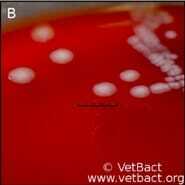Some mastitis pathogens can’t easily be discriminated on culture plates, making a diagnosis difficult. Klebsiella and E. coli are two such Gram-negative pathogens that are known to look very similar, both form large mucoid colonies, and therefore can be easily mistaken for one another when using culture, potentially causing a misdiagnosis if additional tests are not administered. The treatment options for these two pathogens are very different, and a more advanced diagnostic tool, like PCR testing, can offer a clear answer to a farmer’s mastitis problem.

Upclose of Escherichia coli colonies.
Credit: www.vetbact.org and Lise-Lotte Fernström (BVF, SLU) and Karl-Erik Johansson (BVF, SLU)

Large mucoid colonies of Klebsiella oxytoca.
Credit: www.vetbact.org and Ingrid Hansson (SVA) and Karl-Erik Johansson (BVF, SLU and SVA)
About 3% to 5% of all mastitis samples contain Klebsiella, but Klebsiella mastitis infections are increasing in several countries around the world. While Klebsiella isn’t as common as E. coli, the economic impact Klebsiella can have on a dairy herd may be more devastating because of the lack of treatment options. Most cows diagnosed with Klebsiella develop chronic mastitis and are culled due to high cell counts or end up dying. Thus, an accurate diagnosis upfront is critical to bring somatic cell counts (SCC) down and remove Klebsiella from the herd.
Symptoms
Symptoms can range from mild, slightly abnormal milk to systemic signs like fever, no appetite and shock. However, in some cases milk may appear normal, but SCC levels will appear high. Klebsiella deeply attacks the udder tissue, damaging the secretion ability of the gland and creating long-term decreased milk production.
Risk Factors
Known sources of transmission of Klebsiella include bedding, especially sawdust, manure, the udder and legs and barn alleyways. Cows that are early in lactation or immediately following dry off are at a higher risk of developing Klebsiella.
Diagnosis
Identification of chronic cows is important to control the transmission and decrease the infection level in the herd. PCR testing using a mastitis workflow enables the rapid, accurate detection of 15 major mastitis-causing pathogens, including Klebsiella and E. coli. Within one day, farmers and veterinarians can receive a highly accurate diagnosis for the individual pathogens they are testing for, compared to up to 10 days for a culture. Milk samples can even be frozen or preserved without influencing the result.
